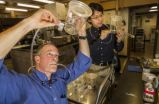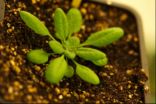(Press-News.org) Cincinnati, OH, May 16, 2014 -- Magnet ingestions by children have received increasing attention over the past 10 years. With the growing availability of new and stronger neodymium-iron-boron magnets being sold as "toys," there has been an increase of cases of ingestion, resulting in serious injury and, in some cases, death. In a new study scheduled for publication in The Journal of Pediatrics, researchers studied the trends of magnetic ingestions at The Hospital for Sick Children (SickKids), Canada's largest children's hospital.
Matt Strickland, MD, and colleagues reviewed all cases of foreign body ingestion seen in the emergency department from April 1, 2002 through December 31, 2012. Inclusion criteria included being less than 18 years of age, with suspected or confirmed magnetic ingestion. According to Dr. Strickland, "We chose to limit our scope to the alimentary tract because the majority of serious harm from magnets arises from perforations and fistulae of the stomach, small bowel, and colon." To reflect the introduction of small, spherical magnet sets in 2009, the study was divided into two time periods, visits during 2002-2009 and those during 2010-2012.
Of 2,722 patient visits for foreign body ingestions, 94 children met the inclusion criteria. Of those, 30 children had confirmed ingestion of multiple magnets. Overall magnet ingestions tripled from 2002-2009 to 2010-2012; the incidence of injuries involving multiple magnets increased almost 10-fold between the two time periods. Six cases required surgery for sepsis or potential for imminent bowel perforation, all of which occurred in 2010-2012. The average size of the magnets also decreased approximately 70% between 2002-2009 and 2010-2012.
This study shows a significant increase in the rate of multiple magnet-related injuries between 2002 and 2012. "More concerning, however," notes Dr. Strickland, "is the increased number of high-risk injuries featuring multiple, smaller magnets." Despite new magnet-specific toy standards, labeling requirements, product recalls, and safety advisories issued in the past 10 years, continuing efforts should focus on educating parents and children on the dangers inherent in magnetic "toys."
INFORMATION: END
Magnets and kids: A dangerous duo
2014-05-16
ELSE PRESS RELEASES FROM THIS DATE:
Study reveals 1 in 10 16-year-olds surveyed have considered self-harm
2014-05-16
One in ten 16-year-olds surveyed in a new study by Queen's University and the University of Ulster have considered self-harm or taking an overdose.
The results of the annual Young Life and Times (YLT) survey, which are published today (Friday 16 May) during Mental Health Awareness Week, also found that almost a third of 16-year-olds questioned had experienced serious personal, emotional or mental health problems at some point in the past year.
1,367 16-year-olds across Northern Ireland took part in the 2013 survey undertaken by ARK, a joint initiative by Queen's University ...
Living conditions in Iraq must improve if investment in health system is to yield results
2014-05-16
Despite enormous investment in Iraq's health system in the 10 years since the US-led invasion, the health condition of Iraqis has deteriorated and will fail to improve unless more is done to improve living conditions. A review published today in the Journal of the Royal Society of Medicine concludes that continual investment in health services is crucial to elevate the health status of the Iraqi population, but that progress will be limited without improvements in housing, water and sanitation, electricity, transport, agriculture, education and employment.
The study was ...
Interrupted breathing during sleep affects brain neurons necessary to regulate heart rate
2014-05-16
Interrupted breathing during sleep affects brain neurons necessary to regulate heart rate
Sufferers of a common sleep-breathing disorder have diminished activity among neurons responsible for keeping heart rate low, reveals a new study published today [16 May] in The Journal of Physiology.
The research discovered that in obstructive sleep apnoea (OSA), neurons in the brainstem that control heart rate experience a blunting of their activity. The reduction of neuronal activity likely contributes to the increased heart rate, blood pressure and risk of adverse cardiovascular ...
Two large meals (breakfast and lunch) better than 6 small meals with same calories for controlling weight and blood sugar in people with type 2 diabetes
2014-05-16
Research published in Diabetologia (the journal of the European Association for the Study of Diabetes) suggests that two large meals (breakfast and lunch), rather than six small meals with the same total calories, are better for controlling weight and blood sugar in people with type 2 diabetes. The research is by Dr Hana Kahleová, Diabetes Centre, Institute for Clinical and Experimental Medicine, Prague, Czech Republic, and colleagues.
The study assessed 54 patients (29 men, 25 women) treated with oral diabetes drugs, aged 30–70 years, BMI 27–50 kg/m2 and HbA1c of 6–11.8% ...
Complex interactions may matter most for longevity
2014-05-16
PROVIDENCE, R.I. [Brown University] — If studying a single gene or a diet that might extend longevity is like searching for a fountain of youth, then a new study calls for looking at something more like the whole watershed. Brown University biologists who experimentally throttled three such factors in fruit flies found that lifespan depended more on interactions among the factors than on the factors themselves.
"I think the main lesson is that these interaction effects are as significant or important as the [single] effects, such as diet effects alone or genetic effect ...
How some trypanosomes cause sleeping sickness while others don't
2014-05-16
Trypanosome parasites transmitted by tsetse flies cause devastating diseases in humans and livestock. Different subspecies infect different hosts: Trypanosoma brucei brucei infects cattle but is non-infectious to humans, whereas T. b. gambiense and T. b. rhodesiense cause sleeping sickness in humans. A study published on May 15th in PLOS Pathogens reveals how humans can fight off some trypanosomes but not others.
Sam Alsford, from the London School of Hygiene and Tropical Medicine, UK, and colleagues, undertook a comprehensive search for genes that make T. b. brucei ...
Walking may have profound benefits for patients with kidney disease
2014-05-16
Washington, DC (May 15, 2014) — For individuals with kidney disease, walking may help prolong life and reduce the risk of needing dialysis or a kidney transplant. That's the conclusion of a study appearing in an upcoming issue of the Clinical Journal of the American Society of Nephrology (CJASN).
Physical inactivity is common among patients with chronic kidney disease (CKD). Che-Yi Chou MD, PhD, Chiz-Tzung Chang, PhD (China Medical University Hospital, in Taiwan) and their colleagues looked to see if an activity as simple as walking might provide benefits to patients. ...
New tool to grow cancer cells streamlines laboratory research
2014-05-16
VIDEO:
Georgetown Lombardi Comprehensive Cancer Center researcher Anna T. Riegel, PhD, discusses a new technique that allows the growth of both normal and cancer cells and keeps them alive indefinitely is...
Click here for more information.
WASHINGTON — A new technique that allows the growth of both normal and cancer cells and keeps them alive indefinitely is transforming and expediting basic cancer research, say investigators from Georgetown Lombardi Comprehensive Cancer Center. ...
New kidney allocation policy could improve the success of transplantations in the US
2014-05-16
Washington, DC (May 15, 2014) — A newly approved US policy regarding allocation of kidneys from deceased donors will likely improve patient and transplant survival, according to a study appearing in an upcoming issue of the Journal of the American Society of Nephrology (JASN). The true effects of the new policy are yet to be seen, however, and officials will evaluate its intended and unintended consequences on an ongoing basis.
In 2013, the Organ Procurement and Transplantation Network in the United States approved a new national deceased donor kidney allocation policy ...
Novel genetic mechanism protects plants from toxic zinc
2014-05-16
Zinc is essential for optimal plant growth and development but when high levels of the metal are present in the soil, it can become toxic to the plant. Consequently, plants need to trigger mechanisms capable of coping with that stress. Researchers from the Instituto Gulbenkian de Ciência (IGC) have now discovered a novel genetic mechanism that protects plants from toxic zinc levels. The research team, led by Paula Duque, identified a gene that produces a protein capable of sequestering zinc inside the cells of the root. In the presence of high levels of zinc, this gene ...


